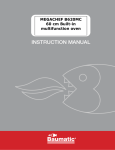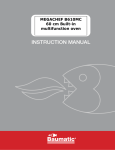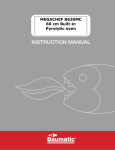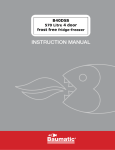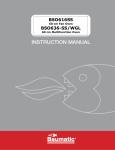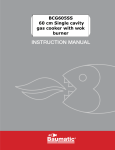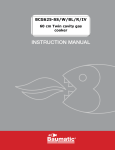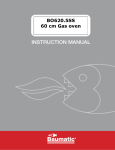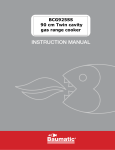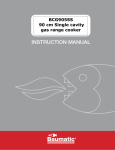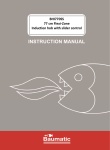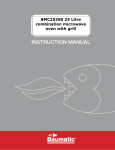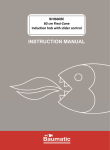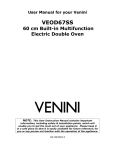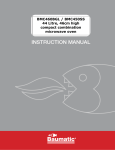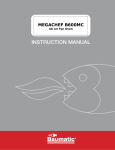Download Baumatic BOD890BL
Transcript
BOD890-SS/BL 90 cm Built-in multifunction electric double oven. 1 User Manual for your Baumatic BOD890-SS/BL 90 cm Built-in multifunction electric double oven NOTE: This User Instruction Manual contains important information, including safety & installation points, which will enable you to get the most out of your appliance. Please keep it in a safe place so that it is easily available for future reference; for you or any person not familiar with the operation of the appliance. GS 25/09/13 2 Contents Environmental note Important safety information 4 5–7 Specifications Product and aperture dimensions Cooling fans Product specifications Standard accessories Electrical details Control panel Oven programmer / timer display 8 – 11 8 9 9 9 9 10 10 Initial set-up of your oven Setting the time of day Before first use 11 – 12 11 11 – 12 Timer functions The minute minder function (main oven and lower oven) The duration function (main oven only) The end cook function (main oven only) The start and end time function (main oven only) Cancelling a timer function Adjusting the audible signal Changing the time of day 12 - 17 12 13 14 15 – 16 16 16 17 Selecting a cooking function and temperature Selecting a main oven function Main oven thermostat control knob Selecting a top oven function Top oven thermostat control knob Oven operating lights (main and lower oven) Cooking guidelines Warnings Shelf positions 17 – 22 17 - 18 18 19 19 20 20 - 21 21 22 Cleaning and maintenance General cleaning instructions Replacing the oven bulb Removing the oven door for cleaning Removing the oven door glass for cleaning Removing the side racks 23 - 27 23 24 25 26 27 Installation Electrical connection Connecting the mains supply cable Replacing the mains supply cable Installing the oven into the kitchen cabinet Positioning the appliance Ventilation requirements 28 – 32 28 29 30 31 31 32 My appliance isn’t working correctly 33 – 35 Cooking Tables Baumatic consumables 36 – 37 38 Contact details 39 3 Environmental note o The packaging materials that Baumatic uses are environmentally friendly and can be recycled. o Please discard all packaging material with due regard for the environment. 4 IMPORTANT SAFETY INFORMATION Your safety is of the utmost importance to Baumatic. Please make sure that you read this instruction booklet before attempting to install or use the appliance. If you are unsure of any of the information contained in this booklet, please contact the Baumatic Advice Line. General Information o This appliance is designed for domestic household use and can be built into a standard kitchen cabinet or housing unit. o IMPORTANT: The adjacent furniture or housing and all materials used in the installation must be able to withstand a minimum temperature of 85°C above the ambient temperature of the room it is located in, whilst in use. o Certain types of vinyl or laminate kitchen furniture are particularly prone to heat damage or discolouration at temperatures below the guidelines given above. o Any damage caused by the appliance being installed in contravention of this temperature limit, or by placing adjacent cabinet materials closer than 4mm to the appliance, will be the liability of the owner. o The use of this appliance for any other purpose or in any other environment without the express agreement of Baumatic Ltd. will invalidate any warranty or liability claim. o Your new appliance is guaranteed against electrical or mechanical defects, subject to certain exclusions that are noted in Baumatic’s Conditions Of Guarantee. The foregoing does not affect your statutory rights. o Repairs may only be carried out by Baumatic service engineers or their authorised service agents. Warning and safety instructions o This appliance complies with all current European safety legislation. Baumatic do wish to emphasise that this compliance does not remove the fact that the appliance surfaces will become hot during use and retain heat after operation. 5 o This appliance is not intended for use by persons (including children) with reduced physical, sensory or mental capabilities, or lack of experience and knowledge, unless they have been given supervision or instruction concerning use of the appliance by a person responsible for their safety. Child Safety o Baumatic strongly recommend that babies and young children are prevented from being near to the appliance and not allowed to touch the appliance at any time. o If it is necessary for younger family members to be in the kitchen, please ensure that they are kept under close supervision at all times. o Children should be supervised to ensure that they do not play with the appliance. General Safety o Do not place heavy objects on the oven door or lean on the oven door when it is open, as this can cause damage to the oven door hinges. o Do not leave heated oil or fat unattended, as this is a fire risk. o Do not place pans or baking trays directly on the base of the oven cavity, or line it with aluminium foil. o Do not allow electrical fittings or cables to come into contact with areas on the appliance that get hot. o Do not use the appliance to heat the room it is located in or to dry clothing. o Do not install the appliance next to curtains or soft furnishings. o Do not attempt to lift or move cooking appliances by using the oven door or handle, as this may cause damage to the appliance or result in injury to the person lifting the appliance. 6 Cleaning o Cleaning of the oven should be carried out on a regular basis. o Great care should be taken whilst using this appliance and when following the cleaning procedure. o IMPORTANT: The appliance must be disconnected from the mains before following the cleaning procedure. Installation This appliance must be correctly installed by a suitably qualified person, strictly in accordance with the manufacturer’s instructions. o Baumatic Ltd. declines any responsibility for injury or damage, to person or property, as a result of improper use or installation of this appliance. o Heat, steam and moisture will be created during use of the appliance, take care to avoid injury and ensure that the room is adequately ventilated. If the appliance is going to be used for prolonged periods of time, then additional ventilation may be required. o Please consult with your qualified installer if you are in any doubt about the amount of ventilation that you will require. Declaration of conformity. This appliance complies with the following European Directives: - 2006/95/EC regarding “low voltage” 2004/108/EC regarding “electromagnetic disturbances” Regulation (EC) N° 1935/2004 regarding “materials in contact with food” o The above directives comply with 93/68/EEC regarding CE marking. o The manufacturer declares that the oven is built using certified materials and requires the appliance to be installed in accordance with the standards currently in force. This appliance must be used by a trained person for domestic purposes only. 7 Specifications Product Dimensions Apature Dimensions Height: Width: Depth: 875-878 mm 565 mm 565 mm 885 mm 595 mm 562 mm Product specifications: o o o o o o o Energy efficiency class: A/A LED full programmer 2 x Cooling fans Thermostatically controlled grills Triple-glazed removable doors Removable inner door glass Mechanically controllable thermostat o o o o Main oven: multifunction oven 9 functions Gross capacity: 60 litres Net capacity: 46 litres o o o o Top oven: static oven and grill 4 functions Gross capacity: 36 litres Net capacity: 25 litres 8 Standard accessories: o o o o Removable side racks 3 x Safety shelves 1 x Enamelled baking tray with handle Trivet Optional Extras: o BPS2 Pizza Stone Cooling fans o Two tangential cooling fans are fitted inside of this appliance, to make the internal temperature of the oven stable and the external surface temperature lower. o After you have finished cooking and switched off the oven, the cooling fan will continue to run for a period of time afterwards. The length of time will depend on how long the oven has been switched on for and at how high a temperature. Electrical details: Rated Voltage: Supply Connection: Max Rated Inputs: Mains Supply Lead: Oven Light Bulb: 220-240V, 50 Hz 25A (double pole switched fused outlet with 3mm contact gap) 5.60 kW 3 x 4.0 mm² (not supplied) 25 W 300°C screw type pygmy For future reference please record the following information which can be found on the rating plate and the date of purchase which can be found on your sales invoice. The rating plate for your oven can be located by opening the bottom oven door and looking on the front frame of the oven chassis. Model Number ………………………………. Serial Number ………………………………. Date of Purchase ………………………………. 9 Control Panel 1) Top oven thermostat knob 2) Top oven operating light 3) Top oven function selection knob 4) Top oven power indicator light 5) LED full programmer (see 11 – 17 below) 6) LED display 7) Main oven power indicator light 8) Main oven function selection knob 9) Main oven operating light 10) Main oven thermostat knob Oven programmer / timer display 11) 12) 13) 14) 15) 16) 17) Minus button Programme button Plus button Auto cooking symbol Oven in use symbol Decimal point symbol Minute minder symbol 10 Initial set-up of your oven Selecting manual operation mode After your appliance is connected to your mains supply for the first time (or after a power-cut) the numbers on the timer display will flash. Before you can select a cooking function or set a temperature, you must set the appliance into “manual operation” mode. o To select manual operation mode, press the program button (12) for three seconds. The oven in use symbol (15) will light in the display. Setting the time of day After your appliance is connected to your mains supply for the first time, you must set the time of day before you can use the oven. o Make sure the oven is in manual operation mode (as outlined above). o Press the program button (12) once to set the time of day. Whilst the decimal point symbol (16) is flashing, use the plus (13) and minus (11) buttons to set the correct time of day. o When the correct time of day is shown on the LED display, release the plus and minus buttons and wait a few seconds. The decimal point symbol (16) will stop flashing and the oven is ready to use. Before first use o To remove any residue from the oven that may have been left from the manufacturing process, you should select the fan oven function and set the thermostat to its maximum temperature setting. o It is perfectly normal for a smell to be produced during this process. o You should make sure that any windows in the room are left open during this process. o It is advisable for you not to remain in the room whilst the burning off process is taking place. o You should leave the oven on maximum setting for 30 – 40 minutes. o After the oven cavity has cooled, it should then be cleaned with warm soapy water, using either a sponge or soft cloth. No abrasive cleaners should be used. 11 o Outer parts of the oven should be cleaned with warm soapy water, using either a sponge or soft cloth. No abrasive cleaners should be used. o We would recommend that an appropriate stainless steel cleaner and polish is regularly used on the stainless steel surfaces of this appliance. Timer functions The minute minder function The minute minder function is a countdown time that can be set on the oven programmer/timer. When the countdown time has finished, an audible signal will sound. o Press the programme button (12) twice. The decimal point (16) starts to flash and the minute minder symbol (17) will light on the display and will show “00:00”. o Use the plus (13) and minus (11) buttons to set the countdown time that you require. o The maximum countdown time that can be set is 23 hours and 59 minutes. o When the correct countdown time appears on the LED display, release the plus and minus buttons and the countdown will start immediately. o The minute minder symbol (17) will remain in the LED display to show that a countdown time is in progress. o After a few seconds the LED display will return to showing the time of day. o At the end of the countdown time, an audible signal will sound and the oven in use symbol will go out. The audible signal will sound for 7 minutes before switching off or you can silence it by pressing any of the oven timer buttons. IMPORTANT: If the oven is in use whilst using the minute minder function, the oven WILL NOT switch off at the end of the countdown time. YOU MUST turn the oven function selector knob and the thermostat control knob to their OFF positions. 12 The semi-automatic cooking function This function will allow you to set a countdown time similar to the minute minder function, however the oven will switch off at the end of the cooking time. o Place the food that you want to cook inside of the oven and close the door. o Select an oven function and cooking temperature using the relevant control knobs. o Press the programme button (12) three times. The decimal point, the oven in use symbol (15) and the Automatic cooking symbol (14) will flash on the LED display. The display will show “00:00”. o Use the plus (13) and minus (11) buttons to set the cooking time that you require. o The maximum countdown time that can be set is 10 hours. o When the correct countdown time appears on the LED display, release the plus and minus buttons. Cooking will begin immediately, after a few seconds the countdown time will start. o At the end of the cooking time the oven will turn off and an audible signal will sound. The automatic cooking symbol (4) and the minute minder symbol (17) will flash on the LED display. o To reset the oven and cancel the audible alarm, press any button once to stop the alarm. Then press and hold the programme button twice for 3 seconds. After the first press the oven time will flash, and on the second press the oven in use symbol appears on the LED display and the automatic cooking (14) symbol goes out. o IMPORTANT: If you have not turned the oven function selector knob and thermostat control knob to their OFF positions, when you reset the oven it will continue to heat. 13 The end of cooking function This function is similar to the semi-automatic function, however instead of setting a countdown time, you select the time of day that you want the oven to switch off at. o Place the food that you want to cook inside of the oven and close the door. o Select an oven function and cooking temperature using the relevant control knobs. o Press the programme button (12) four times. The decimal point starts to flash, and the oven in use symbol (15) and the Automatic cooking symbol (14) will light on the LED display. o The display will show the current time of day which will flash. Use the plus (13) and minus (11) buttons to set the cooking end time that you require. o The maximum end time that can be set is 10 hours into the future. o When the correct end time appears on the LED display, release the plus and minus buttons. Cooking will begin immediately, after a few seconds the countdown time will start. o At the end of the cooking time the oven will turn off and an audible signal will sound. The automatic cooking symbol (14) and the Minute Minder symbol (17) will flash on the LED display. o To reset the oven and cancel the audible alarm, press any button once to stop the alarm. Then press and hold the programme button twice for 3 seconds. After the first press the oven time will flash, and on the second press the oven in use symbol appears on the LED display and the automatic cooking (14) symbol goes out. o IMPORTANT: If you have not turned the oven function selector knob and thermostat control knob to their OFF positions, when you reset the oven it will continue to heat. 14 The automatic cooking function This function will allow you to set the time of day that you want the oven to switch off at and how long you want the oven to cook for. o Place the food that you want to cook inside of the oven and close the door. o Select an oven function and cooking temperature using the relevant control knobs. o Press the programme button (12) three times. The decimal point starts to flash, and the oven in use symbol (15) and the automatic cooking symbol (14) will light on the LED display. o Use the plus (13) and minus (11) buttons to set the cooking time that you require. o The maximum cooking duration time that can be set is 10 hours. o IMMEDIATELY press the programme button. o The display will then show the current time of day which will flash. Use the plus (13) and minus (11) buttons to set the cooking end time that you require. o The maximum end time that can be set is 10 hours into the future. o When the correct end time appears on the LED display, release the plus and minus buttons. o Cooking will begin at the calculated preset time. o At the end of the cooking time the oven will turn off and an audible signal will sound. The automatic cooking symbol (14) and the Minute Minder symbol (17) will flash on the LED display. o To reset the oven and cancel the audible alarm, press any button once to stop the alarm. Then press and hold the programme button twice for 3 seconds. After the first press the oven time will flash, and on the second press the oven in use symbol appears on the LED display and the automatic cooking (14) symbol goes out. o IMPORTANT: If you have not turned the oven function selector knob and thermostat control knob to their OFF positions, when you reset the oven it will continue to heat. 15 Cancelling a timer function o To cancel the minute minder function press the programme button (12) once to select the minute minder function and then reduce the time to “00:00” . o To cancel the semi-automatic timer press the programme button (12) three times to select the semi-automatic timer then and reduce the time to “00:00”. o To cancel the end of cooking timer press the programme button (12) four times to select the end of cooking timer and then reduce the time to the current time of day. o To cancel the automatic timer press the programme button (12) three times and reduce the (duration) time to “00:00” and then press the program button again and reduce the (end) time to the current time of day. o IMPORTANT: If you do not turn the oven function selector knob and thermostat control knob to their OFF positions, when you reset the timer function, it will continue to heat. Adjusting the audible signal The audible signal has 3 tones. To adjust the signal you should proceed as follows:o IMPORTANT: The oven timer must not be in any form of countdown mode and the oven in use symbol (15) must be lit. o Press and hold down the minus (11) and plus (13) buttons simultaneously for 2 seconds and you will hear an audible signal. This is the audible signal which is currently set. o Press and hold down the minus (11) and plus (13) buttons simultaneously again for 2 seconds to hear the next audible signal which will be set. This process can be repeated. o When you hear the audible signal that you wish to use, release all buttons and wait for the display to go back to showing the time of day. The audible signal has now been set. Changing the time of day o IMPORTANT: The oven timer/programmer must not be in any form of countdown mode and the oven in use symbol (15) must be lit. o Please follow the guidelines on “setting the time of day”. 16 Selecting a cooking function and temperature Selecting a main oven function o The main oven function selection knob should be used to select the particular mode of cooking that you require. o The appliance will utilise different elements within the oven cavity, depending on the oven function that you select. o When a function is selected, the main oven power indicator light will come on. Main oven functions DEFROST MODE: The fan runs without heat to reduce the defrosting time of frozen foods. The time required to defrost the food will depend on the room temperature, the quantity and type of food. Always check food packaging for the defrosting instructions. CONVENTIONAL OVEN (top and lower element): This method of cooking provides traditional cooking, with heat from the top and lower elements. This function is suitable for roasting and baking on one shelf only. FAN OVEN: This method of cooking uses the circular element while the heat is distributed by the fan. This results in a faster and more economical cooking process. The fan oven allows food to be cooked simultaneously on different shelves, preventing the transmission of smells and tastes from one dish onto another. HALF GRILL: This method of cooking utilises the inner part of the top element only, which directs heat downwards onto the food. This function is suitable for grilling small portions of bacon, toast and meat etc… FULL GRILL: This method of cooking utilises the inner and outer parts of the top element, which directs heat downwards onto the food. This function is suitable for grilling medium or large portions of sausages, bacon, steaks, fish etc. 17 FAN AND GRILL: This method of cooking utilises the top element in conjunction with the fan, which helps to provide a quick circulation of heat. This function is suitable where quick browning is required and “sealing” the juices in, such as steaks, hamburgers, some vegetables etc. FAN AND LOWER ELEMENT: This method of cooking utilises the bottom element in conjunction with the fan, which helps to circulate the heat. This function is suitable for delicate dishes and heating pre-cooked food. It is also suitable for sterilising and preserving jars. CONVECTION OVEN AND FAN: This method of cooking provides traditional cooking with heat from the top and the lower element, it also utilises the circulation fan. This ensures a fast and even distribution of the heat. Suitable for light and delicate baking, such as pastries. PIZZA FUNCTION: This method of cooking uses the lower and circular elements while the heat is distributed by the fan. It reproduces the same conditions of traditional clay wood-fire stoves. Main oven thermostat control knob o The oven thermostat control knob sets the required temperature of the oven. o It is possible to regulate the temperature within a range of 50 250°C. o The control knob should be turned clockwise. 18 Selecting a top oven function o The top oven function selection knob should be used to select the particular mode of cooking that you require. o The appliance will utilise different elements within the oven cavity, depending on the oven function that you select. o When a function is selected, the top oven power indicator light will come on. Top oven functions OVEN LIGHT: Separate light control which allows the light to be switched on, even when the oven not cooking. LOWER ELEMENT: This method of cooking uses the lower element to direct heat upward to the food. For slow-cooking recipes or for warming up meals. CONVENTIONAL OVEN (top and lower element): This method of cooking provides traditional cooking, with heat from the top and lower elements. This function is suitable for roasting and baking on one shelf only. HALF GRILL: This method of cooking utilises the inner part of the top element only, which directs heat downwards onto the food. This function is suitable for grilling small portions of bacon, toast and meat etc… Top oven thermostat control knob o The oven thermostat control knob sets the required temperature of the oven. o It is possible to regulate the temperature within a range of 50 250°C. o The control knob should be turned clockwise. 19 Oven operating lights (main and top oven) o These lights will come on to indicate that the oven’s heating elements are in operation. o The lights will switch off when the temperature set on the thermostat control knob has been reached. o They will cycle on and off throughout the cooking time. You should not place food inside the cavity, until the correct cooking temperature has been reached. Cooking guidelines o Please refer to the information given on food packaging for guidance on cooking temperatures and times. Once familiar with the performance of your appliance, temperatures and times can be varied to suit personal preference. o If you are using the fan oven function, then you should follow the information given on the food packaging for this particular mode of cooking. o You should pre-heat the oven and not place food inside of it until the oven operating light has gone off. You can choose not to preheat when using the fan oven mode; however you should extend the cooking time given on the food packaging by at least ten minutes. o IMPORTANT: You should pre-heat the oven if you are baking, regardless of whether you are using the main or secondary oven. o If there is no guidance given on the food packaging specifically for cooking in fan oven mode, you can generally reduce the cooking time and temperature by 10% from the information given for conventional oven cooking. 20 o Make sure that frozen foods are thoroughly thawed before cooking, unless the instructions on the food packaging advise that you can “cook from frozen”. o Before cooking, check that any accessories that are not required are removed from the oven. o Place cooking trays in the centre of the oven and leave gaps between the trays to allow air to circulate. o Try to open the door as little as possible to view the dishes. o The oven light will remain on during cooking. Warnings o Keep the oven door closed when using any of the cooking functions, including the grill functions. o Do not use aluminium foil to cover the enamelled baking tray or heat items wrapped in aluminium foil under the grill. The high reflectivity of the foil could potentially damage the grill element. o You should also never line the base of your oven with aluminium foil. o During cooking, never place pans or cookware directly onto the bottom of your oven. They should always be placed on the shelves provided. o The grill heating element and other internal components of the oven become extremely hot during operation, avoid touching them inadvertently when handling the food which you are cooking. o Important: Be careful when opening the door, to avoid contact with hot parts of the oven and steam. o Warning: Accessible parts may become hot during use. Young children should be kept well away from the oven when it is in use. o The enamelled baking tray handle should only be used to reposition the tray and NOT for removing it from the oven cavity. When removing the enamelled baking tray, you should ALWAYS use an oven glove. o The enamelled baking tray handle should not be left in position when the appliance is switched on. 21 Shelf positions Your oven will come supplied with the following oven furniture: (A) Oven shelf (B) Enamelled baking tray o The numbers 1 – 4, indicate the different shelf positions that you can utilise within the oven. (Image for reference only – actual product may differ slightly) o You should use the shelf position(s) that you find are best suited to your personal cooking preferences. o Insert the oven shelf and baking tray between the 2 side rails at any position (1 to 4) on both sides. The oven shelf has safety stops to prevent accidental withdraw. After engaging the oven shelf into the side rails, as you push the oven shelf into the oven, lift the front of the shelf slightly to bypass the stops and allow the oven shelf to slide fully into the rails. o To remove the oven shelf, gently pull the oven shelf outwards. When the shelf stops, lift the front slightly to bypass the safety stops and then completely withdraw the oven shelf from the oven. o When installed correctly, the shelf and tray should be horizontal and not on an angle. 22 Cleaning and maintenance Cleaning or maintenance operations must only be carried out when the oven is cool and with the appliance disconnected from your mains supply. o The oven should be thoroughly cleaned before it is operated for the first time and after each use. This will avoid residual food stuffs becoming baked on the oven cavity. After residues have been baked on several times, they are far more difficult to remove. o Never clean any of the oven surfaces by steam cleaning. o The oven cavity should only be cleaned with warm soapy water, using either a sponge or soft cloth. No abrasive cleaners should be used. o Any stains that may appear on the bottom of the oven will have originated from food splashes or spilt food. These splashes occur during the cooking process. These could possibly be the result of the food being cooked at an excessively high temperature or being placed in cookware that is too small. o You should appropriate ensure that you use the select a cooking temperature and function that is for the food that you are cooking. You should also the food is placed in an adequately sized dish and that drip tray where appropriate. o Outer parts of the oven should only be cleaned with warm soapy water, using either a sponge or soft cloth. No abrasive cleaners should be used. o We would recommend that an appropriate stainless steel cleaner and polish is regularly used on the stainless steel surfaces of this appliance. o If you use any form of oven cleaner on your appliance, then you must check with the manufacturer of the cleaner that it is suitable for use on your appliance. o Do not use harsh or abrasive cleaners or sharp metal scrapers to clean the oven door glass since they can scratch the surface which may result in shattering. o Any damage that is caused to the appliance by a cleaning product will not be fixed by Baumatic free of charge, even if the appliance is within the guarantee period. 23 Replacing the oven bulb IMPORTANT: The oven must be disconnected from your mains supply before you attempt to either remove or replace the oven bulb. o Remove all oven shelves and accessories. o Using a screwdriver, remove the lamp cover (1). o Unscrew the bulb (2) in a clockwise direction and remove it from its holder. o Replace the bulb with a 25 W/300°C, screw type pygmy. o Do not use any other type of bulb. o Place the lamp cover back into its original position. There is a curve on one side of the cover; this should be on the right hand side as the cover goes back into place. 24 Removing the oven door for cleaning To facilitate the cleaning of the inside of the oven and the outer frame of the oven, the door can be removed as follows:o The hinges (A) have two movable bolts on them (B). o If you raise both of the movable bolts (B), then the hinges (A) are released from the oven housing. o You should grip the sides of the door at the centre and then incline it slightly towards the oven cavity and then by pulling it gently away from the oven cavity. o IMPORTANT: You should make sure that the door is supported at all times and that you place the door on some padded material whilst cleaning it. o The oven door and door glass should only be cleaned using a damp cloth and a small amount of detergent. The cloth MUST NOT have come into contact with any form of cleaning product or chemical previously. o To refit the door you should slide the hinges back into their slots and open the door fully. o IMPORTANT: The movable bolts (B) must be closed back into their original positions before closing the door. o Take care not to dislodge the hinge locking system when removing the door, as the hinge mechanism has a strong spring. o Do not immerse the door in water at any time. 25 Removing the inner door glass for cleaning o Do not use any abrasive cleaner that could cause damage. o Remember that if the surface of the glass panel becomes scratched, this could lead to a dangerous failure. o To facilitate cleaning, the inner door glass can be lifted out. o Unscrew the bracket latch that is in the corner of the top of the door. Remove the glass from the door and clean with warm soapy water. o After cleaning, insert the glass panel correctly back into the door. Screw the bracket latch back into place. o IMPORTANT: Remember where the panel of glass is removed from so you can reassemble the door correctly. Do not mix the glasses up or rearrange the order. 26 Removing the side racks IMPORTANT: You can remove the side racks of the oven for ease of cleaning. You can wash the side racks with detergent and/or wash them in a dishwasher. o Pull the side racks free of their securing clips, by pulling them down and away from the clips on oven walls. Then unhook them at the top, and remove them from the oven cavity. o To replace the side racks, insert them back into the oven cavity and hook the top of the racks back into the slots. o Then push the bottom of the rack down, and clip them back onto the securing clips. o Ensure that they are inserted into the correct side of the appliance, and secured back into the securing clamps. 27 INSTALLATION The installation must be carried out by a suitably qualified person, in accordance with the current version of the following. o UK Regulations and Safety Standards or their European Norm Replacements. o Building Regulations (issued by the Department of the Environment). o Building Standards (issued by the Scottish Development Department). o IEE Wiring Regulations. o Electricity At Work Regulations. Before connecting the appliance, make sure that the supply voltage marked on the rating plate corresponds with your mains supply voltage. WARNING: THIS APPLIANCE MUST BE EARTHED. o This appliance should be wired into a 25A double pole switched fused spur outlet, having 3 mm contact separation and placed in an easily accessible position adjacent to the appliance. The spur outlet must still be accessible even when your oven is located in its housing. o To connect the oven power cord, loosen and remove the cover on the terminal block, in order to gain access to the contacts inside. Make the connection, securing the cord in place with the cable clamp provided and then immediately close the terminal block cover again. o If you have to change the oven power cord, the earthing (yellow/green) conductor must always be 10 mm longer than the line conductors. o Care must be taken to ensure that the temperature of the mains supply cable does not exceed 50°C. o If the mains supply cable is damaged, then it must be replaced by an appropriate replacement. o Cable type: H05 RRF 3 core x 4.0 mm² (NOT SUPPLIED) 28 Connecting the mains supply cable o The mains terminal block is located on the rear of the oven and the terminals are accessible by removing the terminal block cover. You should remove the cover screw to access this. o The cable connections must be made in accordance with the diagram below:- o 1 and 2 are the live connection, 4 and 5 are the neutral connection and the remaining one is the earth connection marked with the symbol. o The brass links must be positioned as marked in the diagram above and once established ALL terminal screws must be tightened down firmly. o If when the oven is first switched on, it does not function correctly, you should recheck that the terminal screws are all fully tightened between the links. This should be done before contacting the Customer Care Department. o IMPORTANT: The appliance must NOT be connected to the mains supply by means of a 13A plug and socket. o The cable can be looped if necessary, but make sure that is not kinked or trapped when the oven is in position. Care must be taken to avoid the cable being in contact with hot parts of the appliance. 29 Replacing the mains supply cable o If the mains supply cable is damaged, then it must be replaced with a suitable replacement which can be obtained via the manufacturer, in order to avoid a hazard. o The mains supply cable should be replaced in accordance with the following instructions: o Switch the appliance off at the socket. o Open the terminal block on the back of the oven. o Unscrew the terminal screws fixing the cable. o Replace the cable with one of the same length and in accordance with the specification. o The “green-yellow” earth wire must be connected to the terminal . It must be about 10 mm longer than the live and marked neutral wires. o The “blue” neutral wire must be connected to the terminal marked with letter (N) - the live wire must be connected to the terminal marked with letter (L). o The connection cable must be secured in a strain-relief clamp. 30 Installing the oven into the kitchen cabinet Positioning the appliance o Ensure that the aperture that you will be fitting the oven into is of the size given in the above diagram. o The oven must be fitted into a housing unit with the ventilation cut-outs shown in the “Ventilation requirements” section on the next page. o Ensure that the rear panel of the furniture housing unit has been removed. 31 Ventilation requirements (Figure shows the ventilation and cut-out requirements for the installation of the appliance into a tall housing unit). o Ensure that the oven has been securely fixed into the housing unit. The fixing of the oven into the housing is made by using four screws. These should be screwed through the oven cabinet and into the housing unit. 32 My appliance isn’t working correctly o The ovens aren’t coming on. * Check that the oven is in manual operation mode. * Check that you have selected a cooking function and a cooking temperature. o There appears to be no power to the ovens. * Check that the appliance has been connected to the electrical mains supply correctly. * Check that the mains fuses are in working order. * Check that the operating instructions for setting the time of day and putting the appliance into manual operation mode have been followed. o The grill function works but the main oven does not. * Check that you have selected the correct cooking function. o The grill and top oven element is not working, or cuts out for long periods of time during use. * Allow the oven to cool for approximately 2 hours. Once cool, check whether the appliance is again working properly. o My food is not cooking properly. * Ensure that you are selecting the correct temperature and the correct cooking function for the food that you are cooking. It may be appropriate to adjust your cooking temperature by plus or minus 10°C, to achieve the best cooking results. o My food is not cooking evenly. * Check that the oven has been installed correctly and is level. * Check that the correct temperatures and shelf positions are being used. 33 o The oven light is not working * Refer to the “Replacing the oven bulb” section. o I am getting condensation in my oven * Steam and condensation is a natural by product of cooking any food with high water content, such as frozen food, chicken etc. * You may get condensation in the oven cavity and forming between the oven door glasses. This is not necessarily a sign that the oven is not working correctly. * Do not leave food in the oven to cool after it has been cooked and the oven has been switched off. * Use a covered container, where practical, when cooking to reduce the amount of condensation that forms. 34 IMPORTANT: If your appliance appears not to be operating correctly, then you should disconnect it from your mains supply and then contact Baumatic Customer Care on telephone number (0118) 933 6911. DO NOT ATTEMPT TO REPAIR THE APPLIANCE YOURSELF. Please note that if an engineer is asked to attend whilst the product is under guarantee and finds that the problem is not the result of an appliance fault, then you may be liable for the cost of the call out charge. The appliance must be accessible for the engineer to perform any necessary repair. If your appliance is installed in such a way that an engineer is concerned that damage will be caused to the appliance or your kitchen, then they will not complete a repair. This includes situations where appliances have been tiled in, sealed in with sealant, have wooden obstructions placed in front of the appliance - like plinths, or any installation other than the one specified by Baumatic Ltd. has been completed. Please refer to the conditions of guarantee that appear on the warranty card that you receive with the appliance. IMPORTANT: Baumatic Ltd. operates a policy of continuous improvement and reserves the right to adjust and modify its products without prior notification. 35 Cooking Tables FAN OVEN: This method of cooking uses the circular element while the heat is distributed by the fan. This results in a faster and more economical cooking process. The fan oven allows food to be cooked simultaneously on different shelves, preventing the transmission of smells and tastes from one dish onto another. Food Weight Preheat (kg) (minutes) Beef Pork Chicken Duck Steak Bread 1 1 1.2 1.5 0.8 0.5 15 15 15 15 10 10 Tray position (from bottom) 2 2 2 2 2 2 Temperature setting (˚C) Cooking time (minutes) 200 200 200 200 180 200 40-50 70-80 50-60 50-60 20-30 35-45 CONVENTIONAL OVEN (top and lower element): This method of cooking provides traditional cooking, with heat from the top and lower elements. This function is suitable for roasting and baking on one shelf only. Food Weight Preheat (kg) (minutes) Beef Pork Chicken Duck Steak Bread 1 1 1.2 1.5 0.8 0.5 15 15 15 15 10 10 Tray position (from bottom) 2 2 2 2 2 2 Temperature setting (˚C) Cooking time (minutes) 220 220 220 220 220 220 40-50 70-80 50-60 50-60 20-30 35-45 FAN AND GRILL: This method of cooking utilises the top element in conjunction with the fan, which helps to provide a quick circulation of heat. This function is suitable where quick browning is required and “sealing” the juices in, such as steaks, hamburgers, some vegetables etc. Food Beef Pork Weight Preheat Tray Temperature (kg) (minutes) position setting (from (˚C) bottom) 0.8 10 3 200 0.8 10 3 200 Cooking time (minutes) 20-25 25-30 36 Chicken Sausage Hamburger Corn Vegetable 1.2 0.6 0.6 1.2 0.5 10 10 10 10 10 3 3 3 3 4 200 200 200 200 200 40-45 15-20 15-20 20-25 15-20 FULL GRILL: This method of cooking utilises the inner and outer parts of the top element, which directs heat downwards onto the food. This function is suitable for grilling medium or large portions of sausages, bacon, steaks, fish etc. Food Beef Pork Chicken Sausage Hamburger Corn Vegetable Weight Preheat Tray Temperature Cooking time (minutes) (kg) (minutes) position setting (from (˚C) bottom) 0.8 10 3 250 20-25 0.8 10 3 250 25-30 1.2 10 3 250 40-45 0.6 10 4 250 15-20 0.6 10 4 250 15-20 1.2 10 3 250 20-25 0.5 10 4 250 15-20 FAN AND LOWER ELEMENT: This method of cooking utilises the bottom element in conjunction with the fan, which helps to circulate the heat. This function is suitable for delicate dishes and heating pre-cooked food. It is also suitable for sterilising and preserving jars. Food Bread Pizza Cake Biscuits Fruit salad pie Weight Preheat (kg) (minutes) 0.5 0.7 1.5 0.7 1.2 10 15 15 15 10 Tray position (from bottom) 1 2 1 2 3 Temperature setting (˚C) Cooking time (minutes) 200 200 180 180 250 10-15 40-45 35-40 20-25 20-25 37 Baumatic Consumables o BC001 Degreaser for Dishwashers (200 g) o BC002 Descaler for Washing Machines and Dishwashers (200 g) o BC003 Ceramic Hob Cleaner (250 ml) o BC004 Oven Cleaner (250 ml) o BC005 Stainless Steel Cleaner and Protector (250 ml) o BC007 E-Cloth – General Purpose Cloth o BC008 Microwave Cover To order a Baumatic consumable product please call 0123 5437 244 and quote the product code. You can also order online from eshop.baumatic.co.uk 38 United Kingdom Baumatic Ltd., Baumatic Buildings, 6 Bennet Road, Reading, Berkshire RG2 0QX United Kingdom Czech Republic/Slovakia Baumatic s.r.o. Lípová 665/1 460 01 Liberec 4 Czech Republic Panenská 34 811 03 Bratislava - Staré Mesto Slovakia Sales Telephone (0118) 933 6900 Sales Fax (0118) 931 0035 Customer Care Telephone (0118) 933 6911 Customer Care Fax (0118) 986 9124 Spares Telephone (01235) 437244 Advice Line Telephone (0118) 933 6933 +420 483 577 200 (CZ) +421 255 640 618 (SK) www.baumatic.cz www.baumatic.sk Germany Kundendienst & Ersatzteile Deutschland 0049(0)180-5888975 Oesterreich +43 (0) 820 / 420423 E-mail: [email protected] [email protected] [email protected] [email protected] www.baumatic.de Italy Baumatic Italia S.R.L. Via Galvani N.3 35011 Campodarsego (PD) Website: www.baumatic.co.uk Facebook: www.facebook.com/baumatic.uk +3904 9920 2297 www.baumatic.it Republic of Ireland Holland Baumatic Benelux B.V. Dukdalfweg 15d 1332 BH ALMERE Nederland Service Telephone 1-890 812 724 Spares Telephone 091 756 771 +31(0)36 549 1553/1555 www.baumatic.nl 39 40








































